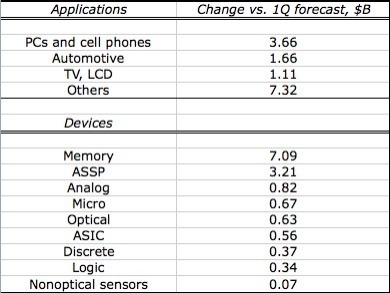by Michael A. Fury, Techcet Group
June 11, 2010 – The 13th IITC (International Interconnect Technology Conference) officially got underway Monday, June 7 at the Hyatt Regency in Burlingame, CA with just under 300 engineers, scientists and technologists in attendance. About 26% traveled from Asia, 12% from Europe and the remaining 62% from the US and Canada, to learn from a program of 43 presentations and 28 posters. Dominant themes this year were variations on 3D and through-silicon vias (TSV), and barrier films for reducing copper electromigration.
 Mark Bohr, Intel CTO, opened the meeting with his keynote address titled "System scaling: The real goal." He’s working on 15nm technology, but limited his discussion to the 45nm products currently in the market. Moore’s Law is continuing, he asserts, but the formula for success is changing. Tight collaboration of process engineers, device designers, and system architects becomes more critical with each generation. Design for low power and portability has fostered adaptive circuitry, in which whole blocks of the microprocessor logic and RAM are switched off when not required. The tolerance for leakage current in mobile electronics is 105 lower than it is for performance computing.
Mark Bohr, Intel CTO, opened the meeting with his keynote address titled "System scaling: The real goal." He’s working on 15nm technology, but limited his discussion to the 45nm products currently in the market. Moore’s Law is continuing, he asserts, but the formula for success is changing. Tight collaboration of process engineers, device designers, and system architects becomes more critical with each generation. Design for low power and portability has fostered adaptive circuitry, in which whole blocks of the microprocessor logic and RAM are switched off when not required. The tolerance for leakage current in mobile electronics is 105 lower than it is for performance computing.
Phil Emma at IBM Research spoke next on "3D systems design: A case for building customized modular systems in 3D." The systems implications for 3D design run beyond the current manifestation that makes things simpler and cheaper. In the near future, 3D will "make things grander;" further out, it will enable us to "make completely new things." These new architectures will be created at the intersection of four basic dimensions in 3D design: packaging density, interconnectivity, modular systems, and heterogeneity.
Hyung Suk Yang of Georgia Tech followed with an example of a 3D interconnect system to provide CMOS signal processing for a large biosensor array. The integration scheme introduces a TSV process that does not require CMP on the MEMS and sensor side of the wafer. It also uses GA Tech’s mechanically flexible interconnect (MFI) design to allow use of disposable sensor units with the drive electronics. The group anticipates that the design will be extendable to meet a demand for up to discrete 50,000 sensor elements on the disposable unit.
A session on Process Integration comprised three papers on self-forming copper barriers, using cobalt (IBM, Albany NanoTech), titanium (Renesas), and manganese (TSMC). In each case, the metal diffuses through the Cu to the surface or sidewall interfaces and functions as the Cu barrier. Each metal gave mixed results as implemented here, but each provided good insights into fundamental mechanisms. Discussions on Co and Mn were underway at RPI under the SEMATECH Center of Excellence (SCOE) in 1988 with Prof. Shyam Murarka — a testament to the incredibly long incubation time for some concepts.
| SEE ALSO: |
Fourteen papers participated in the poster session, covering the whole spectrum of interconnect issues. I particularly enjoyed Matt Spuller’s description of a PECVD boron nitride material from Applied Materials for use as a dielectric copper barrier and as an etch stop. Compared to SiCN (k=5.1), this BN (k=4.2) shows a 30% increase in breakdown voltage and an 8% improvement in RC delay.
The six-paper session on Materials and Unit Processes was dominated by three CMP talks, two of which were given by Nancy Heylen of IMEC. Scratches in ultralow-k (ULK) dielectrics were found to be caused by silica-Ta and silica-TiN agglomerates about 5μm in diameter that form during the polishing process and persist on the pad surface. The agglomerate formation can be mitigated by modifying the chemical environment in which these elements interact. Her other paper demonstrated the effective use of standard electrochemical methods to discern relative compatibilities of Cu, Ta, RuTa, and Co with five unidentified commercial CMP slurries. This is particularly helpful for resolving galvanic corrosion problems between the Cu and its barrier metal. Mark Oliver from Stanford U. reviewed some molecular design considerations for improving the mechanical properties of ULK materials. Of particular interest is a benzene ring with 1,3,5-Si adducts whose bulk modulus vs. density lies well above the line for homologous C-Si compounds.
Michael A. Fury, Ph.D, is senior technology analyst at Techcet Group, LLC, P.O. Box 29, Del Mar, CA 92014; e-mail [email protected].








 The defects most frequently take the form of voids (Device 1) within the seal,
The defects most frequently take the form of voids (Device 1) within the seal,  which may be direct silicon (Si), metallic, glass, or polymer, depending on the reliability level of hermetic seal required as per SEMI MS8-0309. In some locations on a wafer, the seal may be breached (Device 2). Another frequent defect is delamination of the seal from one or both substrates, the result of poor wetting or contamination during fabrication.
which may be direct silicon (Si), metallic, glass, or polymer, depending on the reliability level of hermetic seal required as per SEMI MS8-0309. In some locations on a wafer, the seal may be breached (Device 2). Another frequent defect is delamination of the seal from one or both substrates, the result of poor wetting or contamination during fabrication.

